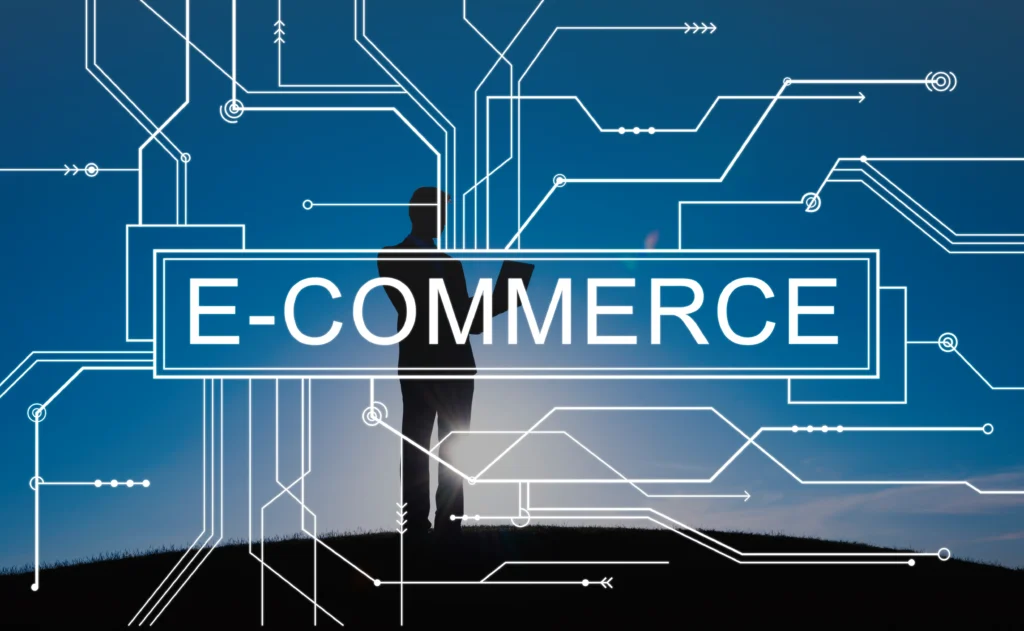
Building E-commerce websites is essential in the rapidly evolving online world, where maintaining a competitive edge is paramount to achieving success. In the future, the e-commerce landscape will continue to evolve, presenting both challenges and opportunities for online retailers. To thrive in this dynamic environment, you need a well-structured and effective e-commerce website. This comprehensive guide delves into the strategies that can set your online store on the path to success in the remainder of 2023 and beyond.
The Ever-Growing E-Commerce Ecosystem

Before we dive into specific strategies, let's take a moment to understand the context. E-commerce has seen remarkable growth over the past decade, with no signs of slowing down. Online shopping has become a way of life for many, and businesses worldwide are vying for their slice of the digital marketplace.
E-Commerce Website Development
Your journey to e-commerce success begins with the foundation of your online store: the website itself. Creating an effective and efficient e-commerce website demands meticulous planning and flawless execution. Here are some key aspects to consider:
Custom vs. Pre-built E-Commerce Solutions
One crucial decision is whether to do a custom-built website or leverage pre-built e-commerce platforms like WooCommerce, Shopify, or Magento. The choice often depends on your specific needs and budget.
Custom-built websites offer unparalleled flexibility and can be tailored precisely to your requirements. This option is suitable for larger businesses with complex needs and unique branding. However, it usually requires a more substantial initial investment and ongoing maintenance.
On the other hand, pre-built platforms offer ease of setup and a range of templates you can choose from. They are ideal for startups and small to medium-sized businesses looking to get their e-commerce operation quickly off the ground. These platforms often provide excellent scalability and support for essential e-commerce features.
Responsive Design
In the age of mobile shopping, building e-commerce websites that are fully responsive is crucial. Google's mobile-first indexing means that search engines prioritize the mobile version of your site when determining rankings. A mobile-friendly design improves your SEO and enhances the user experience.
Consider this: By 2024, mobile e-commerce sales are projected to account for a significant share of total online sales if they are not already. Ensuring your website is fully optimized for mobile users is no longer optional—it's a necessity.
SEO-Friendly Structure
To be found by potential customers, your e-commerce site must be search engine optimized. This includes proper on-page SEO practices such as optimizing product descriptions, meta tags, and image alt text.
Incorporate keywords relevant to your products and industry. In 2023 and beyond, targeting long-tail keywords is essential. For instance, if you sell handmade leather bags, focus on phrases like "luxury handmade leather bags 2023" rather than just "leather bags."
E-Commerce Success Strategies
Building a robust e-commerce website is just the beginning. Success these days requires a strategic approach that encompasses marketing, customer experience, and ongoing optimization.
Content Marketing and Blogging
Content marketing continues to be a powerful tool for e-commerce success. By creating valuable, informative, and engaging content, you can attract and retain customers while also improving your search engine rankings.
Consider starting a blog where you can discuss industry trends, showcase your products, and provide helpful tips to your target audience. This not only positions your brand as an authority but also allows you to incorporate relevant keywords, such as "e-commerce trends 2023" and "online store optimization."
Conversion Rate Optimization (CRO)
Increasing traffic to your e-commerce site is crucial, but it's equally important to convert those visitors into paying customers. Here, CRO becomes crucial!
CRO involves testing and optimizing various elements of your website to improve the percentage of visitors who take the desired action, such as making a purchase. Elements to consider for CRO include your website's layout, product descriptions, call-to-action buttons, and checkout process.
E-Commerce SEO Strategies
Search Engine Optimization (SEO) remains a fundamental component of e-commerce success. In 2023, it's imperative to remain current with the latest SEO best practices. Here are some key strategies to consider:
Keyword Research: Perform comprehensive keyword research to discover the specific terms and phrases that your intended audience is actively seeking. Tools like SEMrush and Ahrefs can help you uncover valuable keywords.
On-Page Optimization: Optimize your product pages with relevant keywords, high-quality images, and well-crafted product descriptions. Employ schema markup to offer search engines well-structured information regarding your products.
Page Speed: Page speed is a ranking factor on Google. Use tools like Google PageSpeed Insights to identify and resolve speed issues on your website.
Mobile Optimization: As previously mentioned, it's imperative to guarantee that your website is thoroughly optimized to cater to mobile devices. Google gives preference to sites that are optimized for mobile devices in its search rankings.
User Experience: A seamless user experience not only improves SEO but also increases customer satisfaction. Ensure your website is easy to navigate, loads quickly, and provides a secure and intuitive checkout process.
E-Commerce Trends for 2023
Building E-Commerce websites that incorporate the latest trends and technologies is essential in 2023. Staying informed and adapting to these changes can give your online store a competitive edge in the evolving e-commerce landscape.
Mobile Commerce Trends
Mobile shopping is here to stay, and it's evolving. Keep an eye on trends such as Progressive Web Apps (PWAs), which offer a more app-like experience on mobile browsers. Additionally, explore the possibilities of augmented reality (AR) and virtual reality (VR) for enhancing the mobile shopping experience.
E-Commerce AI and Automation
Artificial intelligence (AI) and automation are revolutionizing e-commerce. AI-powered chatbots can provide instant customer support, while machine learning algorithms can personalize product recommendations. Embrace these technologies to enhance the customer experience and streamline your operations.
E-Commerce Payment Trends
The payment landscape is evolving, with new methods and technologies emerging. In 2023, consider offering a variety of payment options, including digital wallets, cryptocurrency, and buy now, pay later (BNPL) services. Ensure that your payment gateway is secure and compliant with the latest industry standards, such as PCI DSS.
Online Retail Best Practices

Now that we've explored the broader strategies and trends, let's dive into some best practices that can make a significant impact on your e-commerce success in 2023.
Product Display and Descriptions
Your product pages are the heart of your e-commerce website. To maximize sales, focus on the following:
High-Quality Images and Videos
In the world of e-commerce, visuals matter. Use high-resolution images and, if possible, include videos that showcase your products from multiple angles. In 2023, interactive 360-degree product views and videos demonstrating product use can engage customers and boost conversions.
Compelling Product Descriptions
Well-crafted product descriptions not only inform customers but also persuade them to make a purchase. Use persuasive language, highlight key benefits, and address common customer questions. Integrate the relevant keywords seamlessly to enhance your SEO.
E-Commerce User Experience (UX)
A seamless user experience is vital for keeping customers on your site and encouraging them to make purchases.
Intuitive Navigation
Ensure that your website's navigation is intuitive and user-friendly. Use clear categories and filters to help customers find products quickly. Implement a prominent search bar with auto-suggestions to assist users in their product searches.
Fast and Secure Checkout
One of the most critical aspects of e-commerce success is the checkout process. In 2023, customers expect a friction less and secure experience. Consider these best practices:
- Guest Checkout: Allow customers to check out as guests without the need for account creation.
- Multiple Payment Options: Provide a diverse range of payment options to accommodate various preferences.
- Trust Badges: Display trust badges, SSL certificates, and security icons to reassure customers about the safety of their transactions.
- Progress Indicators: Use progress bars to guide customers through the checkout steps, reducing confusion and cart abandonment.
- Mobile Optimization: Ensure that the checkout process is just as smooth on mobile devices as it is on desktop.
E-Commerce Analytics
To refine your e-commerce strategies and track your progress in 2023, leverage analytics tools. Google Analytics, for example, provides valuable insights into user behavior, conversion rates, and traffic sources.
Frequently assess your analytics data to pinpoint areas that can be enhanced. Are certain products consistently abandoned in carts? Are there specific pages with high bounce rates? Utilize these observations to guide data-informed choices and fine-tune your website accordingly.
E-Commerce Security and Privacy

In an era of increasing online threats and privacy concerns, the security of your e-commerce website is non-negotiable.
E-Commerce Website Security
Protecting customer data and maintaining the integrity of your website is paramount. Integrate strong security measures, including:
- SSL Encryption: Secure your website with SSL encryption to encrypt data transmitted between the user's browser and your server.
- Regular Updates: Keep your e-commerce platform, plugins, and themes up to date to patch security vulnerabilities.
- Firewall Protection: Employ a web application firewall (WAF) to block malicious traffic and attacks.
- Security Audits: Perform routine security assessments and penetration testing to detect potential vulnerabilities.
GDPR Compliance for Online Stores
If your e-commerce business serves customers in the European Union (EU), compliance with the General Data Protection Regulation (GDPR) is mandatory. GDPR governs the handling of personal data and imposes strict requirements on data protection.
Your e-commerce website should:
- Acquires clear and explicit consent for data processing.
- Enables users to access, modify, or delete their data.
- Has a clear privacy policy and cookie policy.
- Appoint a Data Protection Officer (DPO) if necessary.
Payment Card Industry (PCI) Compliance
If you process credit card payments, compliance with the Payment Card Industry Data Security Standard (PCI DSS) is essential. PCI DSS establishes security standards for the management of credit card information.
Choose a payment gateway that complies with PCI DSS, and ensure that your website does not store sensitive cardholder data. Regularly validate your compliance to maintain a secure payment environment.
Customer Experience in E-Commerce

Exceptional customer experiences can turn first-time shoppers into loyal customers.
E-Commerce Customer Reviews
Positive customer reviews and testimonials build trust and credibility. Encourage satisfied customers to leave reviews, and respond promptly to any negative feedback with a focus on problem resolution.
Personalization in Online Shopping
In 2023, personalization is not a mere option—it's an expectation. Utilize data-driven personalization techniques to provide tailored product recommendations and offers to individual customers. Personalized email marketing and dynamic website content can enhance the shopping experience.
E-Commerce Customer Service
Building E-commerce websites with responsive customer service as a cornerstone of success is supreme. Provide various support channels, encompassing email, live chat, and phone assistance. Implement chatbots to provide instant answers to common queries, and ensure that customer inquiries are addressed promptly and professionally.
E-Commerce Shipping and Delivery
Fast and reliable shipping is critical to customer satisfaction. Consider offering a variety of shipping options, including expedited and same-day delivery where feasible. Provide transparent tracking information so customers can monitor the progress of their orders.
E-Commerce Metrics and KPIs

To measure the success of your e-commerce strategies in 2023, track key performance indicators (KPIs) and metrics. Building E-Commerce Websites with robust analytics tools can provide valuable insights into customer behavior and sales trends, allowing you to fine-tune your strategies for optimal results. Additionally, regularly reviewing these data points ensures you stay agile in responding to changing market dynamics.
E-Commerce Key Performance Indicators (KPIs)
- Conversion Rate: The proportion (%) of website visitors who complete a purchase.
- Average Order Value (AOV): The typical (avg.) spending per order for every customer.
- Customer Acquisition Cost (CAC): The expense associated with acquiring a fresh customer, as well as marketing costs.
- Shopping Cart Abandonment Rate: The rate at which customers abandon their shopping carts before completing a purchase.
- Customer Lifetime Value (CLV): The total value a customer is predicted to contribute to your business during their entire relationship with your brand.
By regularly monitoring these KPIs and making data-driven adjustments to your strategies, you can optimize your e-commerce website for ongoing success in 2023 and beyond.
Conclusion

Building e-commerce websites successfully in 2023 demands a holistic approach that encompasses website development, strategic planning, and a commitment to delivering exceptional customer experiences. By staying informed about industry trends, embracing technological advancements, and prioritizing security and user experience, you can position your online store for growth and prosperity.
Remember that building E-commerce websites in the digital landscape is a dynamic process, and what works today may need adjustments tomorrow. Continuously adapt and evolve your strategies to meet the changing demands of your customers and the market. With dedication and the right strategies in place, your e-commerce website can thrive in the competitive world of online retail in 2023 and beyond.
As you've now discovered the paramount importance of building a website in our digital age, we invite you to take the next step. If you are ready to unlock the full potential of your online presence, book a call with our experts today and embark on a journey towards digital success.